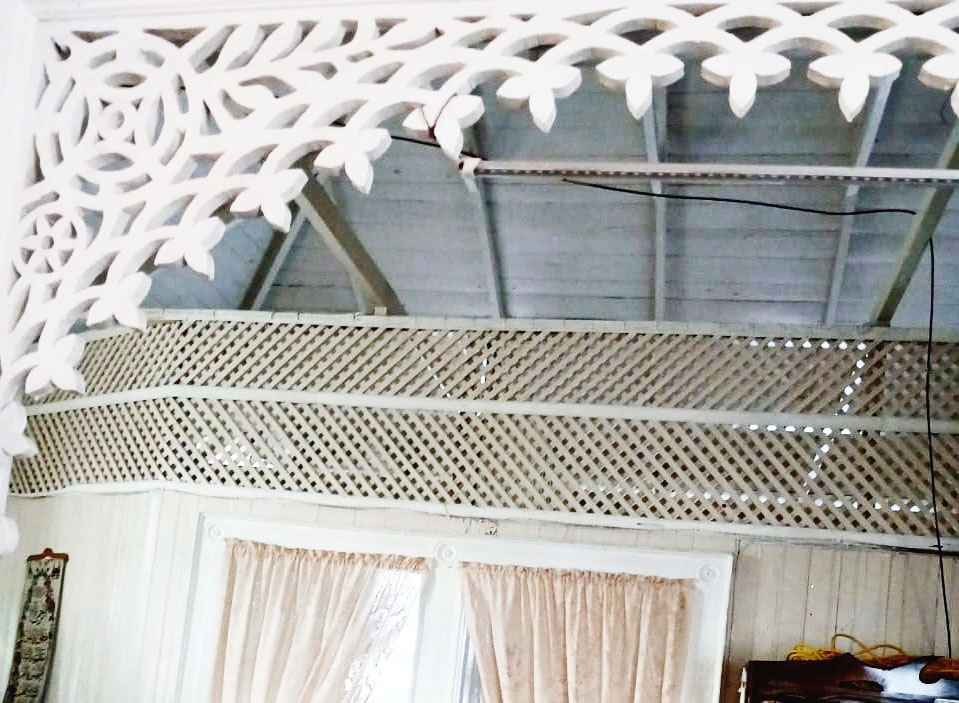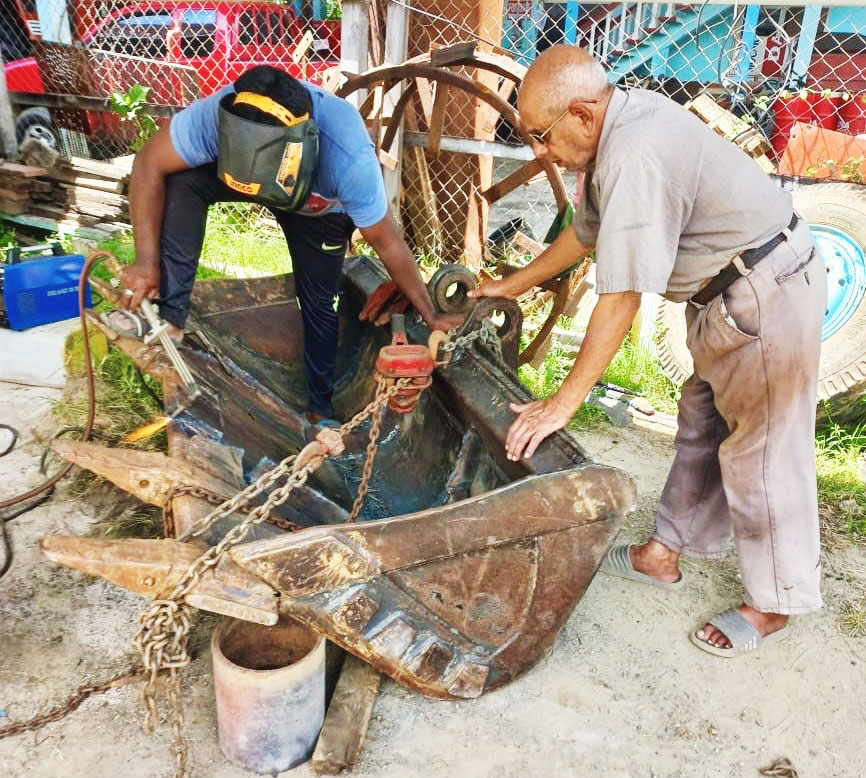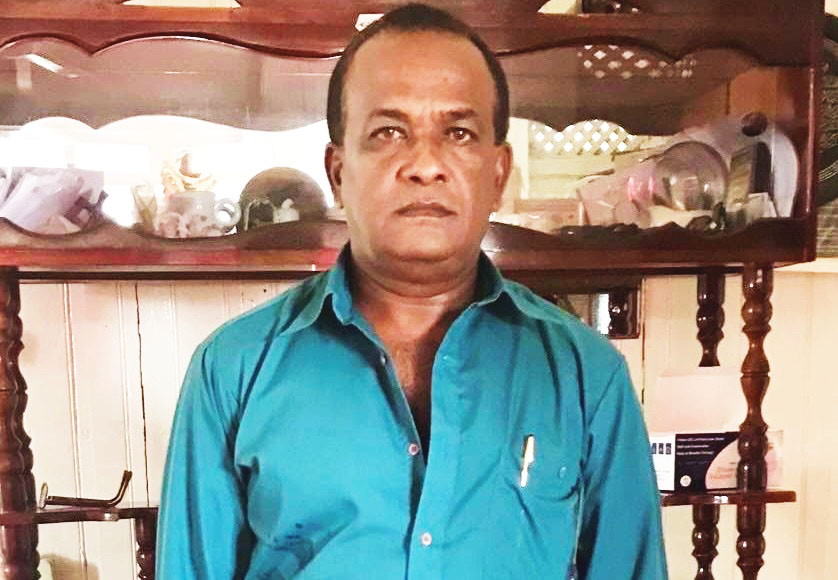By Shabna Rahman
With three houses up in flames side-by-side on July 1st, the occupants and others fought desperately to save a fourth dwelling that was under threat at Lot 14 ‘B’ Bush Lot, West Coast Berbice (WCB), averting what could have been an even bigger catastrophe.
The one-flat, wooden three-bedroom antique property that houses a welding workshop and a storeroom below, belongs to 87-year-old Wallim Ullah, a welder and fabricator. In front of the house is a separate flat concrete structure, which is rented for a phone store.
At the time of the fire around 5:30 pm, Ullah was at home with his son-in-law, Robby Saywack when they smelt the smoke.
Upon checking, they saw fumes emanating from the front room in Carl “Carly” Persaud’s house, two doors away at Lot 16 ‘B’ Bush Lot.

Persaud was heard screaming for help but the blaze spread rapidly and sadly, when it was extinguished a few hours later, his charred remains were pulled from the rubble.
Saywack’s first instinct was to call the Onverwagt Fire Service and the Fort Wellington Police Station. Initially, both calls went unanswered but he persisted until someone from the fire service eventually picked up. He informed them of the fire and hurried out of the house. They also started driving the vehicles out of the yard.
Other family members who had just returned home, started removing important documents, furniture and other items to safety. Public-spirited citizens also pitched in to help.
Saywack recalled that he saw when the fire started spreading rapidly to the second room in Persaud’s house before billowing into thick smoke, engulfing the entire building. That house was owned by Persaud’s father, the late Kenneth “KP” Persaud, who was a school teacher.
In no time it ignited the house on Persaud’s left at Lot 15 ‘B,’ that belonged to his late uncle, Arnold Persaud, also a teacher who was well-known in the village as ‘Teacher Kidd.’
According to Saywack, while the fire was halfway burning ‘Teacher Kidd’s’ house, on the right of their house, the one on Persaud’s right at Lot 17 ‘B,’ started burning. This was occupied by a teacher, 46-year-old Sundnrada “Natasha” Jagmohan.
Historical landmark
In an interview with Stabroek News, Ullah, the last of 10 siblings and the only one alive, pointed out that his father, who was a welder, blacksmith, joiner and carpenter, along with his older brothers, built the house about 85 years ago. It is the oldest house in the village and stands as an historical landmark.
They used logs they got from the Abary Creek after cutting down trees, for the pillars. His father also bought timbers, which were 30 feet in length and four feet in width, from a man who found them at sea.
They split them with a “long saw and used the board to floor the house.” They also used some of the board to build a dining table and a wardrobe. They bought greenheart wood for the walls and also used it to carve a lattice work design for the interior, by hand.
Ullah said he was deeply traumatised as he watched the other buildings go up in flames. His fears were that the house would have also been ravaged.
He remarked sadly: “I don’t know what woulda happen to me if this house had catch afire. I woulda lose everything… my welding plant and all my tools and everything woulda gone.” Despite his age, he still does welding but has “eased up” and has passed his skills on to his grandson, Javed.
The heat from the burning building next door had started to affect his side wall and even shattered some glasses, but he kept praying for his house to be saved.
He was grateful for the support from residents of Bush Lot, Hopetown, Bath Settlement, Number 9 Village, Cotton Tree and other areas, as well as members of the cricket team that Saywack and his son, Javed are a part of.
They came out in full force and formed a bucket brigade, dousing the building in a successful effort to keep the fire away.
They also had to break the shed next door to “bring the fire to the ground” and to prevent it from spreading.
That was happening simultaneously as the fire tenders were trying to quell the blaze, and as Saywack and Javed, were setting up an “engine pump.”
They attached it to water tanks in the yard and joined in the battle to save their house. Luckily, the breeze was blowing across the road and not in the direction of the house. Saywack told this newspaper that “had this building gone up (in flames), the entire block would have gone…”
Adamant
Saywack was adamant that the blaze could have been contained to Persaud’s house and the two other buildings could have been saved, if the fire tenders had not come empty and with faulty hoses.
He spoke to one of the fire-fighters who said that the tenders were designed to carry water to activate the pumps and not to fight the fire. After that, he said they needed a steady supply, but there was no trench nearby to source water. Eventually they had to access water from a trench in the other village.
They were also unable to access water from the hydrant because the Guyana Power & Light had to shut off the power, resulting in the Guyana Water Inc line also being shut off.
There are suggestions that every fire tender should carry a 10,000 gallon tanker behind it so there would always be a ready supply.

He was extremely thankful for the co-operation from so many people, including one man who was in a bus heading to Essequibo. The man, who was an acquaintance, exited the bus to lend a helping hand.
Saywack also singled out a resident and good friend, who despite having medical complaints, was a part of the bucket brigade. He stayed until the end when the house was out of danger, and said he has to “go home and get his medication.”
He found it heart rending too when one of the firefighters told him, “My brother, I can’t do anything… and he bent his head down and he burst into tears.” This happened when they tried to activate the hose to give the pressure, but it was only going up to about six feet.
“The hose was no good. I gave them a brand new tractor tube to cut it and tie the hose. But every time they tied one spot another spot erupted. The road was like a full fledged wash bay.”
Regardless, he credited the fire-fighters for working “within the limits that they could operate. My opinion is you cannot give a fire man a basket to put out fire. It just wouldn’t work!”
He commended four off-duty firefighters for picking up their protective gear and rushing to render assistance. He was also grateful for the presence of Minister of Home Affairs, Robeson Benn and other government officials, at the scene on the night of the fire.






